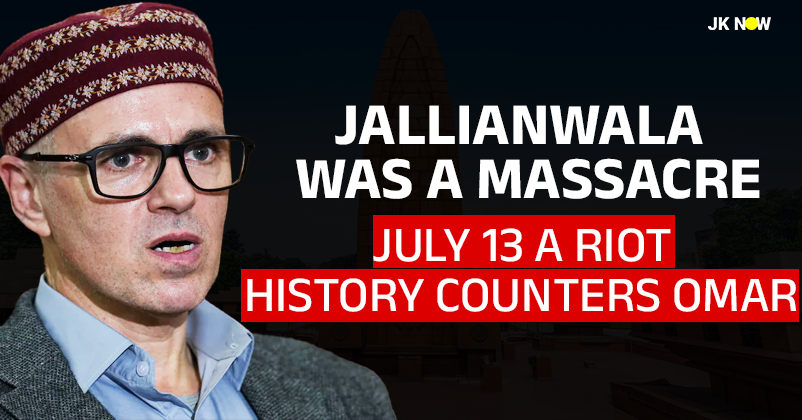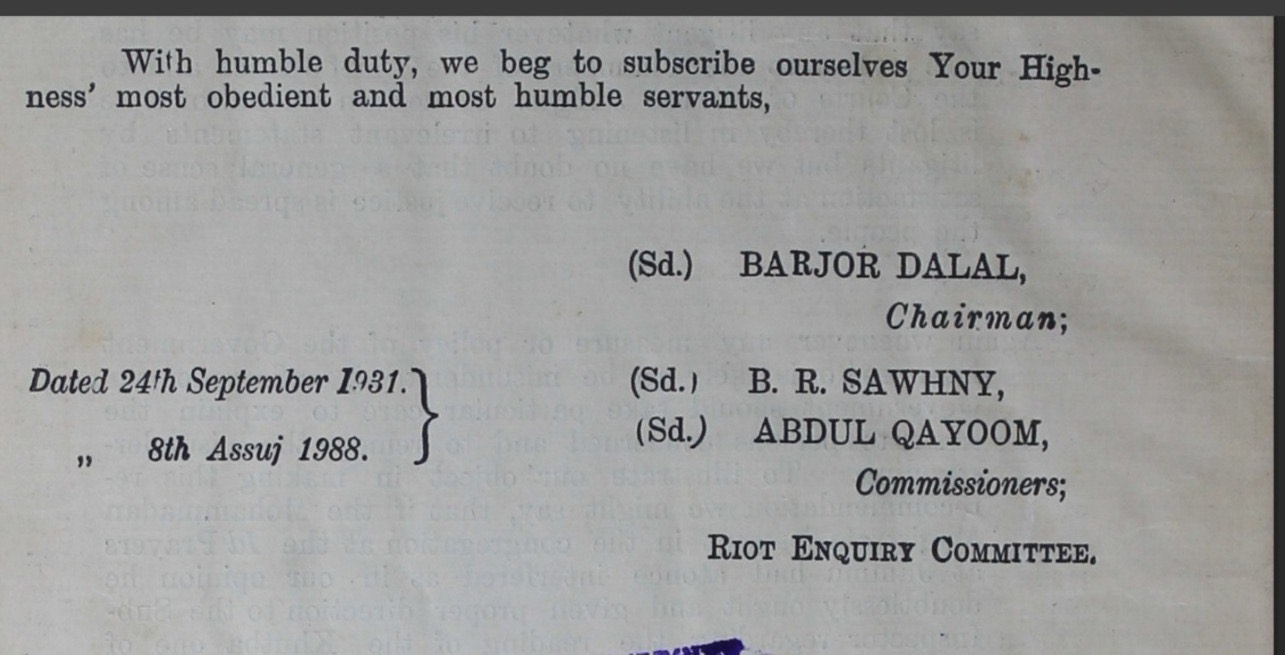Jallianwala Bagh was a Massacre of Innocents, July 13 was a Communal Riot: History Disproves Omar Abdullah
14 Jul 2025 15:11:27

J&K Chief Minister Omar Abdullah compared the violent events of July 13, 1931, with the Jallianwala Bagh massacre of April 13, 1919, which is drawing widespread criticism for equating two vastly different historical incidents.
In a post on X, Omar wrote, “13 July massacre is our Jallianwala Bagh. The people who laid down their lives did so against the British. Kashmir was being ruled under the British Paramountcy. What a shame that true heroes who fought against British rule in all its forms are today projected as villains only because they were Muslims. We may be denied the opportunity to visit their graves today but we will not forget their sacrifices.”
Omar Abdullah’s comparison between the July 13, 1931 events and the Jallianwala Bagh massacre (13 April, 1919) is completely wrong. Jallianwala Bagh was a peaceful gathering of innocent Indian civilians (including men, women and children) who were demanding freedom. They were unarmed and brutally killed by British soldiers led by Gen. Dyer. It was one of the darkest chapters of British colonial brutality.
In contrast, the events of July 13, 1931, were completely different. It was not a peaceful protest. It was marked by violence, communal tension, and political motives against Dogra Maharaja Hari Singh’s rule. What followed was not a freedom struggle but a wave of lawlessness and communal violence, including attacks on Hindu shops and religious sites. Comparing the two is unfair, misleading and it insults the real sacrifice made by the victims (martyrs) of Jallianwala Bagh.
Story of 13 July, 1931 and Dalal Report
After the 13 July, 1931 incident, on 14 July 1931, a commission was formed to investigate the riots in Srinagar. It is commonly known as the "Barjor Dalal Commission," named after its chairman, Sir Barjor Dalal.
The Srinagar Riots Inquiry Committee of 1931 was chaired by Sir Barjor Jamshedji Dalal, who served as the Chief Justice of the Jammu and Kashmir High Court. The committee also included B.R. Sawhny, a judge of the High Court, as an official judicial member, along with Abdul Qayoom, another official judicial member from the Jammu and Kashmir judiciary. Together, they were tasked with investigating the events surrounding the riots that took place on July 13, 1931.

The commission completed its investigation and released the report in 1932. The report provided a detailed account of the events, causes, and consequences of the riots that occurred on July 13, 1931.
As per the findings, On June 21, 1931, a man named Abdul Qadir, who had come from Peshawar as a cook for a British military officer, delivered a provocative religious speech at Khanqah-e-Moula. In his address, he invoked verses from the Quran to incite communal sentiments among the audience. Following his provocative speech, he was arrested on charges of sedition and incitement to violence.
On July 13, 1931, in the morning, a large crowd gathered outside the Central Jail as thousands of people came to witness the hearing of Abdul Qadir. When the Sessions Judge entered the jail, the crowd attempted to force their way inside, breaking down some doors and tearing apart the inner gates. By noon, violence erupted as the crowd began to stone the police and attempted to free the prisoners. Despite repeated warnings from the police, the crowd refused to disperse. The District Magistrate declared the gathering an unlawful assembly and ordered the crowd to disperse. Ignoring this order, the police opened fire, resulting in the deaths of 22 Muslim violent protesters.
Immediately after the gunfire, the Muslim crowd turned violent. Attacks began on Hindu shops in several markets in Srinagar, particularly in Maharajganj, Bohri Kadal, Ali Kadal, Safa Kadal, and Nawa Kadal. Hindu stores were looted, set on fire, and their papers and account books were destroyed. The violence spread to Vicharanag and surrounding areas, where incidents of looting, rape, and assaults were reported. Three Hindus were killed, and 163 others were injured in the mayhem.
A portion of the crowd moved towards the Hari Parbat Fort, where cavalry was deployed. The agitation spread to remote areas such as Kotli, Mirpur, Rajouri, and Bhimber. The Hindu and Sikh communities faced atrocities, including forced conversions, murders, rapes, and desecration of temples and gurdwaras.
Key findings of Dalal Report:
The report acknowledged that during the riots, Hindu properties were looted, and shops and temples were targeted.
“There can be no doubt as to loot having taken place at Maharajgunj Bazar, in Vicharnag and in other quarters of Hindu shops and houses by the Mohammadans.”
Over 500 cases of forced conversions were recorded in Rajouri, Kotli, and Bhimber (Rajouri - 120, Bhimber - 206, Kotli - 224). The victims did not receive any compensation, and attempts were made to conceal the truth.
Impact of Riots:
These riots were later commemorated as "July 13 Martyrs' Day," which the Hindu community remembers as a 'Black Day’. The Barjor Dalal Report clearly stated that the violence was not one-sided, and the atrocities committed against the Hindu community cannot be overlooked.
‘Story of Black Day in Jammu’
The story of "Black Day" in Jammu unfolds as communal riots spread to areas like Mirpur, Kotli, Rajouri, and others, creating devastating conditions. Properties belonging to Hindus and Sikhs were looted and burned, innocent people were brutally murdered, and many were forcibly converted to Islam. Hindu and Sikh religious sites, temples and gurdwaras, were completely destroyed or desecrated. In some cases, buildings remained standing, but idols and sacred texts, such as the Guru Granth Sahib, were defiled and burned.
According to documents preserved in the British Library, London, a letter from Mr. Jardin, Wazir Khazana, J&K, to Mr. R.L. Waltiner, Deputy Secretary, Government of India, states that:
31 places of worship were completely looted and destroyed. Recorded cases of forced conversions by administrative officials included:
Tehsil Rajouri – 120, Seri – 12, Bhimber – 206 and Kotli – 224.
Government Holiday in J&K Until 2019
Until 2019, July 13 was observed as “Kashmir Martyrs' Day” in Jammu and Kashmir, which was a public holiday in the region. However, in 2020, the Jammu and Kashmir administration officially revoked the government holiday for "Kashmir Martyrs' Day" celebrated on July 13.
Important Details:
On June 26, 2020, the Jammu and Kashmir administration released a new list of gazetted holidays and removed July 13 (Martyrs' Day) from it.
The National Conference and various other Muslim ideological organizations in Jammu and Kashmir have long claimed that on July 13, 1931, the Dogra rulers, who were Hindu Maharajas of a Muslim-majority Jammu and Kashmir, ordered their forces to fire upon Muslim protesters in Srinagar, resulting in the martyrdom of 13 protesters. This day is commemorated in their memory as Kashmir Martyrs' Day.
However, the truth is that violent protests and subsequent actions by state forces led to orchestrated riots in Hindu-majority areas around Srinagar, resulting in murders, arson, and the looting of Hindu markets.